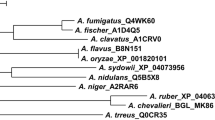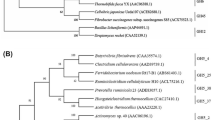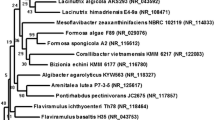Abstract
A 1329 nucleotide long endoglucanase gene was amplified from marine bacterium Photobacterium panuliri strain LBS5T.The enzyme sequence was novel as protein-based similarity search revealed that it shared maximum similarity of 99 % with hypothetical protein of P. aquae and 40 % with endoglucanase of P. marinum AK15. The gene was cloned, overexpressed in Escherichia coli BL21 (DE3), and purified up to homogeneity using Ni-NTA affinity chromatography. The purified enzyme, designated as Cel8, was monomeric and has a molecular mass of 53 kDa. The enzyme was halostable and exhibited optimal carboxymethyl cellulase (CMCase) activity and stability at 2 M NaCl. Optimal activity was obtained at 40 °C and at pH 4. The enzyme exhibited remarkable stability in different organic solvents (50 %, v/v), and activity increased nearly 1.5-fold in presence of butanol, isopropanol, petroleum ether, benzene, acetone, and n-hexane. It was active in Ca2+, Ba2+, and Ni2+ and inhibited by Co2+, Cd2+, Zn2+, Cu2+, and Hg2+. Under normal physiological conditions, the enzyme has 25 % helix, 30 % sheets, and 56 % irregularities, whereas salt leads to helix to sheet transition in enzyme. Three-dimensional reconstruction analysis revealed that the enzyme has (α/β)8 structure and a TIM barrel fold-like structure at the central groove of enzyme. This is the first evidenced report on halostable, organic solvent tolerant cellulase in the marine bacterial genus Photobacterium.






Similar content being viewed by others
References
Zhang, X. Z., & Zhang, Y. H. P. (2013). Cellulases: characteristics, sources, production, and applications. In S. T. Yang, H. A. El-Enshasy, & N. Thongchul (Eds.), Bioprocessing technologies in biorefinery for sustainable production of fuels, chemicals, and polymers. Hoboken: John Wiley & Sons, Inc.
Azevedo, H., Bishop, D., & Cavaco-Paulo, A. (2000). Effects of agitation level on the adsorption, desorption, and activities on cotton fabrics of full length and core domains of EGV (Humicola insolens) and CenA (Cellulomonas fimi). Enzyme and Microbial Technology, 27, 325–329.
Murashimaa, K., Nishimuraa, T., Nakamuraa, Y., Kogaa, J., Moriyab, T., Sumidab, N., et al. (2002). Purification and characterization of new endo-1,4-β-D-glucanases from Rhizopus oryzae. Enzyme and Microbial Technology, 30, 319–326.
Maki, M., Leung, K. T., & Qin, W. (2009). The prospects of cellulase-producing bacteria for the bioconversion of lignocellulosic biomass. International Journal of Biological Sciences, 5, 500–516.
Gomez, J., & Steiner, W. (2004). The biocatalytic potential of extremophiles and extremozymes. Food Technology and Biotechnology, 2, 223–235.
Marhuenda-Egea, F. C., & Bonete, M. J. (2002). Extreme halophilic enzymes in organic solvents. Current Opinion in Biotechnology, 13, 385–389.
Wang, C. Y., Hsieh, Y. R., Ng, C. C., Chan, H., Lin, H. T., Tzeng, W. S., & Shyu, Y. T. (2009). Purification and characterization of a novel halostable cellulase from Salinivibrio sp. strain NTU-05. Enzyme and Microbial Technology, 44, 373–379.
Simankova, M. V., Chernych, N. A., Osipov, G. A., & Zavarzin, G. A. (1993). Halocella cellulolytica gen. nov., sp. nov., a new obligately anaerobic, halophilic, cellulolytic bacterium. Systematic and Applied Microbiology, 16, 385–389.
Huang, X., Shao, Z., Hong, Y., Lin, L., Li, C., Huang, F., Wang, H., & Liu, Z. (2010). Cel8H, a novel endoglucanase from the halophilic bacterium Halomonas sp. S66-4: molecular cloning, heterogonous expression, and biochemical characterization. Journal of Microbiology, 48, 318–324.
Hirasawa, K., Uchimura, K., Kashiwa, M., Grant, W. D., Ito, S., Kobayashi, T., & Horikoshi, K. (2006). Salt-activated endoglucanase of a strain of alkaliphilic Bacillus agaradhaerens. Antonie van Leeuwenhoek, 89, 211–219.
Aygan, A., & Arikan, B. (2008). A new halo-alkaliphilic, thermostable endoglucanase from moderately halophilic Bacillus sp. C14 isolated from Van Soda Lake. International Journal of Agriculture and Biology, 10, 369–374.
Li, X., Wang, H. L., Li, T., & Yu, H. Y. (2012). Purification and characterization of an organic solvent-tolerant alkaline cellulase from a halophilic isolate of Thalassobacillus. Biotechnology Letters, 34, 1531–1536.
Deep, K., Poddar, A., & Das, S. K. (2014). Photobacterium panuliri sp. nov., an alkalitolerant marine bacterium isolated from eggs of spiny lobster, Panulirus penicillatus from Andaman Sea. Current Microbiology, 69, 660–668.
Tabor, S. (1990). Expression using the T7 RNA polymerase/promoter system. In F. A. Ausubel, R. Brent, R. E. Kingston, D. D. Moore, J. G. Seidman, J. A. Smith, & K. Struhl (Eds.), Current protocols in molecular biology (pp. 16.2.1–16.2.11). NY: Greene Publishing and Wiley-Interscience.
Boyd, J., Oza, M. N., & Murphy, J. R. (1990). Molecular cloning and DNA sequence analysis of a diphtheria tox iron-dependent regulatory element (dtxR) from Corynebacterium diphtheriae. Proceedings of the National Academy of Sciences of the United States of America, 87, 5968–5972.
Altschul, S. F., Madden, T. L., Schaffer, A. A., Zhang, J., Zhang, Z., Miller, W., et al. (1997). Gapped BLAST and PSI-BLAST: a new generation of protein database search programs. Nucleic Acids Research, 25, 3389–3402.
Laemmli, U. K. (1970). Cleavage of structural proteins during the assembly of the head of bacteriophage T4. Nature, 227, 680–685.
Bernfeld, P. (1955). Amylases α and β. Method Enzymol, 1, 149–158.
Li, X., & Yu, H. Y. (2012). Purification and characterization of an organic-solvent-tolerant cellulase from a halotolerant isolate, Bacillus sp. L1. Journal of Industrial Microbiology and Biotechnology, 39, 1117–1124.
Bailey, T. L., Bodén, M., Buske, F. A., Frith, M., Grant, C. E., et al. (2009). MEME SUITE: tools for motif discovery and searching. Nucleic Acids Research, 37, W202–W208.
Tamura, K., Peterson, D., Peterson, N., Stecher, G., Nei, M., & Kumar, S. (2011). MEGA 5: molecular evolutionary genetics analysis using maximum likelihood, evolutionary distance, and maximum parsimony methods. Molecular Biology and Evolution, 10, 2731–2739.
Saitou, N., & Nei, M. (1987). The neighbor-joining method: a new method for reconstructing phylogenetic trees. Molecular Biology and Evolution, 4, 406–42526.
Ciria, R., Abreu-Goodger, C., Morett, E., & Merino, E. (2004). GeConT: gene context analysis. Bioinformatics, 14, 2307–2308.
Kelley, L. A., Mezulis, S., Yates, C. M., Wass, M. N., & Sternberg, M. J. (2015). The Phyre2 web portal for protein modelling, prediction and analysis. Nature Protocols, 10, 845–858.
Seeliger, D., & de Groot, B. L. (2010). Ligand docking and binding site analysis with PyMOL and Autodock/Vina. Journal of Computer-Aided Molecular Design, 24, 417–422.
Roy, A., Yang, J., & Zhang, Y. (2012). COFACTOR: An accurate comparative algorithm for structure-based protein function annotation. Nucleic Acids Research, 40, W471–W477.
Wiedemann, C., Bellstedt, P., & Görlach, M. (2013). CAPITO—a web server based analysis and plotting tool for circular dichroism data. Bioinformatics, 29, 1750–1757.
Bohm, G., Muhr, R., & Jaenicke, R. (1992). CDNN: quantitative analysis of protein far UV circular dichroism spectra by neural networks. Protein Engineering, 5, 191–195.
Baneyx, F. (1999). Recombinant protein expression in Escherichia coli. Current Opinion in Biotechnology, 10, 411–421.
Klinke, H. B., Thomsen, A. B., & Ahring, B. K. (2004). Inhibition of ethanol producing yeast and bacteria by degradation products produced during pre-treatment of biomass. Applied Microbiology and Biotechnology, 66, 10–26.
Park, J. I., Steen, E. J., Burd, H., Evans, S. S., Redding-Johnson, A. M., Batth, T., et al. (2012). A thermophilic ionic liquid-tolerant cellulase cocktail for the production of cellulosic biofuels. PLoS ONE, 7, e37010.
Zhang, T., Datta, S., Eichler, J., Ivanova, N., Axen, S. D., et al. (2011). Identification of a haloalkaliphilic and thermostable cellulase with improved ionic liquid tolerance. Green Chemistry, 13, 2083–2090.
Trincone, A. (2011). Marine biocatalysts: enzymatic features and applications. Marine Drugs, 9, 478–499.
Zhang, G., Li, S., Xue, Y., Mao, L., & Ma, Y. (2012). Effects of salts on activity of halophilic cellulase with glucomannanase activity isolated from alkaliphilic and halophilic Bacillus sp. BG-CS10. Extremophiles, 16, 35–43.
Gaur Voget, S., Steele, H. L., & Streit, W. R. (2006). Characterization of a metagenome-derived halotolerant cellulase. Journal of Biotechnology, 126, 26–36.
Doukyu, N., & Ogino, H. (2010). Organic solvent-tolerant enzymes. Biochemical Engineering Journal, 48, 270–282.
Gaur, R., & Tiwari, S. (2015). Isolation, production, purification and characterization of an organic-solvent-thermostable alkalophilic cellulase from Bacillus vallismortis RG-07. BMC Biotechnology, 15, 19.
Trivedi, N., Gupta, V., Kumar, M., Kumari, P., Reddy, C. R., & Jha, B. (2011). Solvent tolerant marine bacterium Bacillus aquimaris secreting organic solvent stable alkaline cellulase. Chemosphere, 83, 706–712.
Hu, Y., Zhang, G. M., Li, A. Y., Chen, J., & L. X., M. (2008). Cloning and enzymatic characterization of a xylanase gene from a soil derived metagenomic library with an efficient approach. Applied Microbiology and Biotechnology, 80, 823–830.
Singh, J., Batra, N., & Sobti, R. C. (2004). Purification and characterization of alkaline cellulase produced by a novel isolate, Bacillus sphaericus JS1. Journal of Industrial Microbiology and Biotechnology, 31, 51–56.
Coolbear, T., Whittaker, J. M., & Daniel, R. M. (1992). The effect of metal ions on the activity and thermostability of the extracellular proteinase from a thermophilic Bacillus, strain EA.1. Biochemical Journal , 287, 367–374.
Sierecka, J. K. (1989). Purification and partial characterization of a neutral protease from a virulent strain of Bacillus cereus. The International Journal of Biochemistry & Cell Biology , 30, 579–595.
Yang, J., Roy, A., & Zhang, Y. (2013). BioLiP: a semi-manually curated database for biologically relevant ligand-protein interactions. Nucleic Acids Research, 41, D1096–D1103.
Kelly, S. M., Jess, T. J., & Price, N. C. (2005). How to study proteins by circular dichroism. Biochimica et Biophysica Acta, 1751, 119–139.
Acknowledgments
We are grateful to the Central Instrumentation Facilities at Bose Institute, Kolkata, for CD spectroscopic analysis. This work was supported in part by the funding received from Ministry of Earth Sciences, Government of India (MoES/11-MRDF/1/59/P/08), and Department of Biotechnology, Government of India (D.O. No. BT/PR7661/AAQ/3/629/2013) to SKD. The authors, KD and AP, acknowledge the University Grant Commission (UGC) and Council of Scientific and Industrial Research (CSIR), Government of India, New Delhi, respectively, for providing the research fellowship.
Author information
Authors and Affiliations
Corresponding author
Ethics declarations
Conflict of Interest
No conflict of interest exists.
Electronic Supplementary Material
Below is the link to the electronic supplementary material.
ESM 1
(DOCX 2763 kb)
Rights and permissions
About this article
Cite this article
Deep, K., Poddar, A. & Das, S.K. Cloning, Overexpression, and Characterization of Halostable, Solvent-Tolerant Novel β-Endoglucanase from a Marine Bacterium Photobacterium panuliri LBS5T (DSM 27646T). Appl Biochem Biotechnol 178, 695–709 (2016). https://doi.org/10.1007/s12010-015-1903-9
Received:
Accepted:
Published:
Issue Date:
DOI: https://doi.org/10.1007/s12010-015-1903-9




